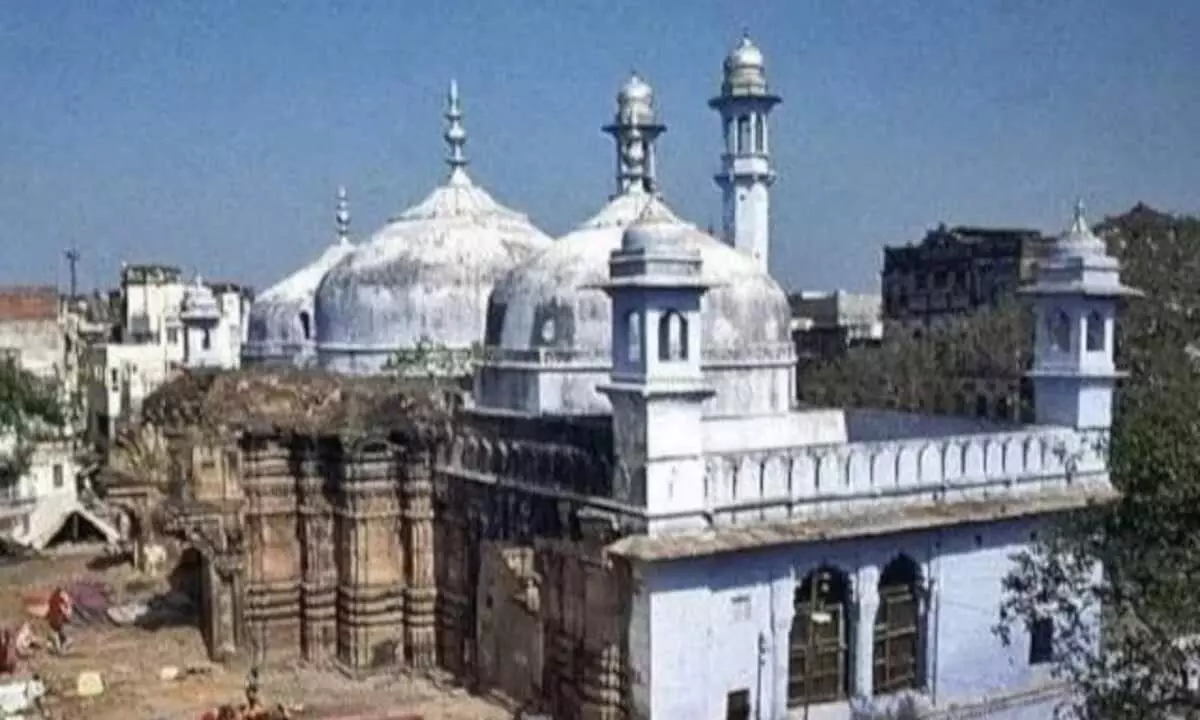Live
- After caste census, Dalits, tribals, poor will recognise their true strength: Rahul Gandhi
- Who was Birsa Munda, whose 'Ulgulan' declared the end of British rule in Jharkhand?
- Five selected as Indian Rhodes Scholars for 2025
- Raj Thackeray releases MNS election Manifesto with a ‘key’ to implementing it
- COP29: 3 methodologies approved for issuing high-integrity carbon credits
- MP: Celebrations of Birsa Munda's birth anniversary begin in presence of Guv, CM in Shahdol
- NGT seeks details of waste to energy plants not complying with norms
- Dev Deepawali 2024: Significance, Rituals, and How to Celebrate with Lamps
- Air quality in Kolkata dips to ‘very unhealthy’ category
- Air pollution may raise risk of lung cancer, asthma in children, say experts
Just In
Time for discussion and reconciliation


Time for discussion and reconciliation
The reductionist contention promoted by India’s woke liberal cabal that the dispute over the Gyanvapi mosque is a vile expression of hate, a rabid exhibition of Hindu bigotry and a majoritarian excess is too simplistic to be plausible and too inane to be intellectually acceptable.
The reductionist contention promoted by India's woke liberal cabal that the dispute over the Gyanvapi mosque is a vile expression of hate, a rabid exhibition of Hindu bigotry and a majoritarian excess is too simplistic to be plausible and too inane to be intellectually acceptable. The Gyanvapi mosque-Kashi Vishwanath temple imbroglio symbolises something far greater than a mere communal dispute over a place of worship. At stake is the ethos of a civilisation, the essential core of a religion and above all it represents a test of justice, of whether right will prevail or will the evil of a past stand tall to mock the moral order of the present.
Hate is an expedient terminology to brand one's ideological adversaries as irrational and radical – A strategy that has been consistently employed to silence those fighting for the rights of Hindus. Tavleen Singh in her weekly column ('Evil Under the Sun'; 22 May 2022, Indian Express) avers: "The ugly truth is that once the genie of hatred is released, it is hard to contain. So, it is no longer about righting the wrongs of history or about reclaiming ancient temples, it is about how much we hate Muslims."
Wrong. Opposing a wrong is not hate. Hate is what was done to the Hindus. The physical destruction of temple and its deity is a tangible expression of hate that surpasses any vocal vituperation; an act of unparalleled blasphemy far more offensive than any verbal indiscretion which no sane human can and should defend.
That this destruction involved the holiest of holy Hindu shrines adds insult to injury and magnifies the degree of the crime The Kashi Vishwanath temple is the epicenter of Hinduism. Dedicated to the Hindu God Shiva, this temple houses one of the 12 jyotirlingas (symbolic representation of Shiva) and is arguably Hinduism's most sacred temple.
Archeological data and historical references date the Kashi Vishwanath temple to at least the first century AD. Religious scriptures place it even earlier. Over the years this sacred edifice has been destroyed by Islamic invaders and rebuilt several times. The last known destruction occurred at the hands of the Islamic Moghul Emperor Aurangzeb in 1669. Aurangzeb not only demolished this holiest of Hindu shrines but erected a mosque in its place – the Gyanvapi mosque which takes its name from the ancient wisdom well of the temple located close to it. Parts of the original temple however were retained and are expressly visible even today, nearly 300 years after the end of Mughal rule and 75 years after a predominantly Hindu government was established-constant reminders of the humiliation, hurt and agony of the Hindus.
The current Kashi Vishwanath temple was built by Rani Ahilyabai Holkar, the queen of Indore, in 1777 adjacent to the original site.
The destruction of the Kashi Vishwanath temple was a spiritual apocalypse for Hindus; the ultimate desecration designed to crush their inner identity, dehumanize them and make them ripe for religious transformation. It is akin to St Peter's Basilica being razed to the ground by marauding invaders and replaced by a temple of another denomination; a temple that continues to stand as a monument of hurtful ignominy even 300 years after the invasion has been repulsed.
That Aurangzeb demolished the Kashi Vishwanath temple and built a mosque in its place is not a historical conjecture open to debate or a fantasy of the Hindu right wing as some are prone to claim but a fact firmed by irrefutable historical evidence. Aurangzeb stands indicted by his own written order and by the documentation of partisan Islamic chroniclers.
Maasir-i-Alamgiri is an authorised account of Aurangzeb's rule written by Saqi Mustad Khan a contemporary of Aurangzeb; it was completed in 1710 (three years after Aurangzeb's death) and later translated into English by Jadunath Sarkar, the famous Indian historian. On page 55, Saqi Mustad Khan states: "It was reported that, according to the Emperor's command, his officers had demolished the temple of Viswanath at Kashi."
A copy of the firman/order is still available at the Asiatic Library in Kolkata. (https://www.rediff.com/news/report/hindu-devotees-cite-british-era-stand-in-gyanvapi-dispute-to-buttress-claim/20220523.htm).
Even the rabidly anti-Hindutva historian Audrey Truschke, an otherwise enthusiastic cheerleader for the Mughal ruler, Aurangzeb, in her book, The Man and the Myth, is forced to confess this crime: "Aurangzeb brought the bulk of Benares's Vishvanatha Temple down in 1669. …. The Gyanvapi Masjid still stands today in Benares with part of the ruined temple's wall incorporated into the building."
(Courtesy: First Post)

© 2024 Hyderabad Media House Limited/The Hans India. All rights reserved. Powered by hocalwire.com






